

This is a list of amphibians and reptiles found on the island of Saint Vincent, located in the Caribbean Lesser Antilles. It is the main island of the nation Saint Vincent and the Grenadines.


This is a list of amphibians and reptiles found on the island of Saint Vincent, located in the Caribbean Lesser Antilles. It is the main island of the nation Saint Vincent and the Grenadines.
There are four species of amphibian on Saint Vincent, one of which was introduced. One species, Eleutherodactylus shrevei , is endemic.
| Tropical frogs (Leptodactylidae) | |||
|---|---|---|---|
| Species | Common name(s) | Notes | Image |
| Eleutherodactylus johnstonei | Lesser Antillean whistling frog, coqui Antillano, Johnstone's whistling frog | Least concern. [1] | 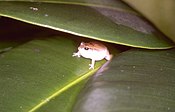 |
| Eleutherodactylus shrevei | Endangered. Endemic. Restricted to pristine montane forest. | ||
| Leptodactylus validus | Windward ditch frog | Least concern. Regional endemic. Typically found in forest habitats, but may venture into human-altered areas. | |
| True toads (Bufonidae) | |||
| Species | Common name(s) | Notes | Image |
| Bufo marinus | Cane toad, giant Neotropical toad, marine toad | Least concern. Introduced. |  |
Including marine turtles and introduced species, there are 16 reptile species reported on Saint Vincent, three of which are endemic.
| Scaly sea turtles (Cheloniidae) | |||
|---|---|---|---|
| Species | Common name(s) | Notes | Image |
| Caretta caretta | Loggerhead turtle | Endangered. |  |
| Chelonia mydas | Green turtle | Endangered. | 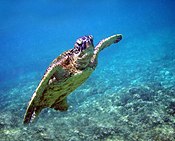 |
| Eretmochelys imbricata | Hawksbill turtle | Critically endangered. |  |
| Leathery sea turtles (Dermochelyidae) | |||
| Species | Common name(s) | Notes | Image |
| Dermochelys coriacea | Leatherback turtle | Critically endangered. |  |
| Geckos (Gekkonidae) | |||
|---|---|---|---|
| Species | Common name(s) | Notes | Image |
| Hemidactylus mabouia | House gecko | Introduced. |  |
| Sphaerodactylus vincenti | Vincent's least gecko | Regional endemic. |  |
| Thecadactylus rapicauda | Turnip-tailed gecko |  | |
| Iguanas and anolids (Iguanidae) | |||
| Species | Common name(s) | Notes | Image |
| Anolis griseus | Saint Vincent's tree anole | Endemic. Widely distributed from sea level to 900 m. | |
| Anolis trinitatis | Saint Vincent's bush anole, Trinidad anole | Regional endemic. Widely distributed from sea level to 900 m. | |
| Iguana iguana | Green iguana, common iguana | 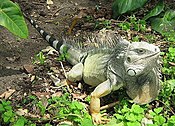 | |
| Microteiids (Gymnophthalmidae) | |||
| Species | Common name(s) | Notes | Image |
| Gymnophthalmus underwoodi | Underwood's spectacled tegu | ||
| Skinks (Scincidae) | |||
| Species | Common name(s) | Notes | Image |
| Mabuya mabouya [2] | Regional endemic. Possibly extirpated. | 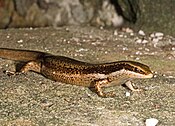 | |
| Boas (Boidae) | |||
| Species | Common name(s) | Notes | Image |
| Corallus cookii [3] | Cook's tree boa | Endemic. Found in many habitats, though uncommon in rain forest. | |
| Colubrids (Colubridae) | |||
| Species | Common name(s) | Notes | Image |
| Chironius vincenti | Saint Vincent blacksnake | Critically endangered. Endemic. Probably restricted to elevations between 150 and 330 m. | |
| Mastigodryas bruesi | Barbour's tropical racer | Regional endemic. Found in xeric habitats in the southwest. | |
The Saint Vincent blacksnake, also commonly known as the Saint Vincent coachwhip, the San Vincent racer, and Vincent's sipo, is a species of snake in the family Colubridae.
The Sombrero ameiva, also known commonly as the Sombrero groundlizard, is a species of lizard in the family Teiidae. The species is endemic to Sombrero, a small, uninhabited island in the Lesser Antilles under the jurisdiction of Anguilla. The species was originally described in the genus Ameiva.

Pholidoscelis plei, known commonly as the Anguilla Bank ameiva or the Caribbean ameiva, is a species of lizard in the family Teiidae. The species is found on the Caribbean islands of Anguilla, Saint Martin, and Saint Barthélemy in the Lesser Antilles. Its coloration and markings vary between each island population. Two subspecies are recognized as being valid, including the nominotypical subspecies.
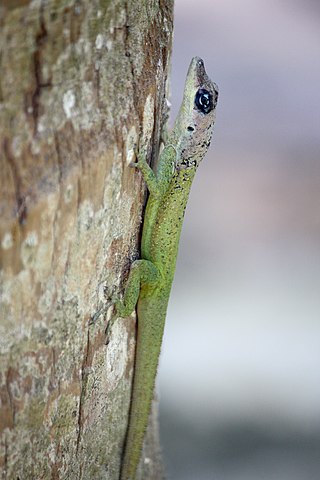
The Barbados anole is a species of anole lizard that is native to Barbados, an island-nation in the Caribbean. Originally endemic to Barbados, it has since been introduced to Saint Lucia and Bermuda. It was previously treated as a subspecies of Martinique's anole, A. roquet.

The Barbados leaf-toed gecko is a species of gecko endemic to the Caribbean island-nation of Barbados. It is the only known leaf-toed gecko in the Lesser Antilles.
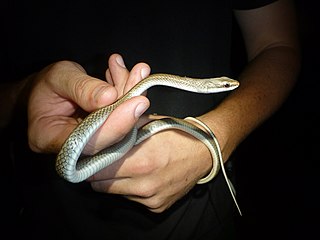
Barbour's tropical racer is a species of snake in the family Colubridae. The species is endemic to the Caribbean.
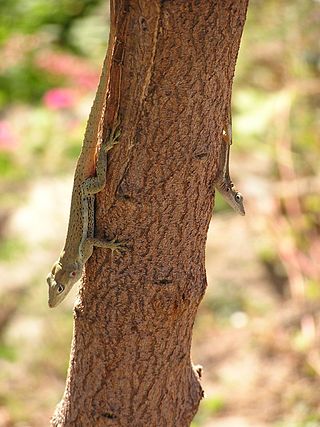
Anolis gingivinus, also known as the Anguilla Bank tree anole, Anguilla bank anole, and Anguilla anole, is a species of anole lizard that is endemic to the Caribbean Lesser Antilles islands of Anguilla and its satellites, such as Saint Martin, and Saint Barthélemy.
Anolis griseus, the Saint Vincent's tree anole or Saint Vincent tree anole, is a species of anole lizard.
Note: All species listed above are supported by Malhotra & Thorpe 1999, unless otherwise cited.